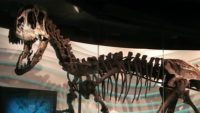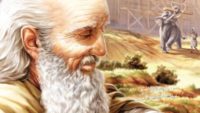If there was something the church could do to keep its young people, wouldn’t you want to know what that was? …read more Read more here: creation.com
By Ken Ham About a year ago, we took Ebenezer, our Allosaurus—or at least its skull—on a trip to Cincinnati, Ohio, for a CT (computer tomography) scan at 3D Engineering Solutions. Now, we are getting a first look inside the brain cavity of one of the largest and most complete Allosaurus skulls in the world. And you can be a part of it! On my Facebook page, we will be filming a Facebook Live video around 10:30 a.m. on Tuesday, November 15, at 3D Engineering Solutions. We’ll look at the x-ray equipment used to scan the skull (one of only [More]
By Dr. Danny R. Faulkner Scientists increasingly talk and write about the multiverse. What is the multiverse? The multiverse is the belief that our universe is just one of many. …read more Read more here: AIG Daily
By Creation Moments While Creation Moments is outspoken in criticizing evolution, we are just as vocal about extolling the work of scientists who are doing real science – especially the science that benefits mankind. For example, scientists are now working on developing a “second skin” for soldiers that would protect them from biological and chemical weapons. read more …read more Read more here: Creation Moments
By Ken Ham It’s an enormous blessing for me to count Dr. Johnny Hunt among my good friends. As the pastor of First Baptist Church of Woodstock in Northwest Atlanta, Georgia, and former president of the Southern Baptist Convention, Dr. Hunt has worked tirelessly in the service of our Lord, reaching thousands with the gospel. He has invited me to speak at his church on many occasions, and I invited him to visit the Creation Museum and attend the July 5 ribbon cutting for the new Ark Encounter here in Northern Kentucky. You see, our friendship is built on our [More]
By Joel Leineweber Anyone who doesn’t think that creation really matters should take the time to seriously consider these seven reasons. …read more Read more here: AIG Daily
By Dr. Greg Hall Unity is not only in Christ and His truth, but is maintained by committing to that truth and not being persuaded otherwise by men. …read more Read more here: AIG Daily
Carbon-14 in Diamonds is still a problem for evolutionists. …read more Read more here: creation.com
By Creation Moments Should a parrot be allowed to testify at a murder trial if the bird appears to be an ear-witness to the crime? That’s a question that is ruffling the feathers of animal experts and legal eagles alike! read more …read more Read more here: Creation Moments
By Ken Ham Have you ever wanted to chat with Noah and ask him questions about the Ark? That would certainly be quite the conversation! Well, here are three ways that you can get a glimpse of how Noah might have answered some of your questions. Order The Noah Interview DVD. To entertain visitors waiting in the queue line under the life-size Noah’s Ark at the Ark Encounter in Northern Kentucky, we produced a drama that features a pre-Flood tabloid reporter questioning Noah about his enormous construction project. This often-funny production answers some of the most common questions about Noah’s [More]
By Michael Todhunter Fall may make us wonder, “Did Adam and Eve ever see such brilliant colors in the Garden of Eden?” …read more Read more here: AIG Daily
Why did Moses use different names for God in Genesis chapters 1 and 2? …read more Read more here: creation.com
By Creation Moments All of us have seen ivy clinging to the sides of houses and trees, but did you know that these climbing plants can withstand the force of hurricane and tornado-force winds? What gives them such sticking power? Well, an article at the Engineering360 website points out that scientists are now learning that ivy “might hold the key to manufacturing stronger adhesives, more durable paints and even cosmetics with better staying power.” read more …read more Read more here: Creation Moments
Our endowment fund is one of the ways we financially sustain our mission and work and there are four ways you may contribute toward it. …read more Read more here: AIG Daily
Is a mutation that seemingly reduces risk of cardiovascular disease an example of evolution in action? …read more Read more here: creation.com
By schaffee This episode of ID the Future features part two of an interview with Dr. Charles Thaxton, one of the first intelligent design scientists in the modern ID movement. Critics of intelligent design often try to frame ID as a political response to court rulings striking down the teaching of creationism. Today origin of life theorist and chemist Charles Thaxton tells the true history of intelligent design as a modern scientific movement fueled by new discoveries and critical examination of the evidence by open minds. Listen in as Dr. Thaxton explains what led him to ID and tells the [More]
By schaffee This episode of ID the Future features part one of an interview by Casey Luskin with CSC Fellow Charles Thaxton, co-author of The Mystery of Life’s Origin (1984), a foundational work for the intelligent design movement. Listen in as Dr. Thaxton takes us back to the first stirrings of the modern intelligent design movement and discusses the chemical challenge to naturalistic origin of life theories. Charles Thaxton is a member of the American Chemical Society, the American Association for the Advancement of Science, the American Scientific Affiliation and a Fellow of the American Institute of Chemistry. Your browser [More]
By Ken Ham Once again here in Northern Kentucky, Answers in Genesis employees and their families are busy gathering items to pack in shoeboxes that will travel to children around the world. It is an honor to give children items that they need and can have fun with. Though the choices of items to pack are endless, there are four important items that should be included in each shoebox. Just a few of the shoeboxes collected from the Answers in Genesis staff. School supplies. These supplies, such as notebooks, pens, and pencils, will be vital to many children getting an [More]
By Dr. David Menton Dogs are always sniffing around, but it’s not because they’re always hungry. Unlike us, they interpret the world primarily through smell. …read more Read more here: AIG Daily
Sneak peek of latest Creation magazine. Humans occupy a unique place in the universe that evolutionists cannot adequately explain. …read more Read more here: creation.com
By Multimedia On this episode of ID the Future, Andrew McDiarmid interviews Douglas Axe on his recent book, Undeniable. Axe shares his reasons for writing the volume, defines common science, and describes what a new biology, with intelligent design, not Darwinism, might resemble.Your browser does not support playing Audio, please upgrade your browser or find our podcast on podOmatic Download Episode …read more Read more here: id the future
By Ken Ham Every year tens of thousands of visitors come to the Creation Museum in Petersburg, Kentucky (near the Cincinnati Airport), during the month of December for our spectacular Christmas Town event. This special free outreach draws visitors from all across the country, but it’s also become an annual tradition with many local families. This year we have added dates so more families can experience and celebrate Christmas Town with us. Christmas Town features a free live nativity that recreates the events surrounding our Savior’s birth, and a spectacularly unique garden of tens of thousands of gorgeous lights rivaling [More]
Buried bones, ancient carvings, and cave paintings reveal early European cow-types. Some had the large shoulder humps of bison, some showed the big horns of the extinct aurochs—extinct ancestors of modern cattle—and others seemed like hybrids between these forms. Classic Darwinian evolution asserts one ancestor for various descendants. These supposedly separate into isolated species which can’t breed, like tree branches extending far from their trunk. A recent study exposed how this concept clashes with the actual trends in cow-kind variation. More… …read more Read more here: icr.org
If the Bible cannot be trusted in what it teaches about history, why should anybody trust it in anything else? …read more Read more here: creation.com
By Creation Moments For me, catching a fish of any size is a great accomplishment … but can you imagine what it would be like to find a gigantic Mola mola at the end of your fishing line? Also known as the ocean sunray, the Mola mola is the world’s largest bony fish, weighing as much as 5,000 pounds and measuring up to 14 feet from top to bottom! read more …read more Read more here: Creation Moments
By Ken Ham You know, there’s an old children’s song that says, “Do you know, oh Christian, you’re a sermon in shoes?” Well, you might be a sermon in shoes, but did you know that the gospel can also be a shoebox? Each year Operation Christmas Child, a ministry of Samaritan’s Purse, ships shoeboxes full of small presents to boys and girls all over the world. Millions of children are introduced to the gospel of Jesus Christ through this ministry. And you can help! Start with an average-sized shoebox (what better excuse to buy a new pair of shoes?). Following [More]
Man looked to the birds, and conquered the skies. Now researchers are looking to imitate a much tinier winged creature … …read more Read more here: creation.com







































